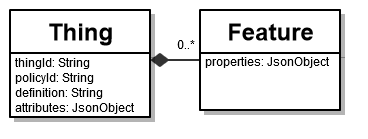Domain model
Eclipse Ditto does not claim to know exactly which structure Things in the
IoT have or should have.
Its idea is to be as agnostic as possible when it comes to Thing data.
Nevertheless two coarse elements are defined in order to structure Things (see also Thing):
- Attributes: intended for managing static meta data of a
Thing- as JSON object - which does not change frequently. - Features: intended for managing state data (e.g. sensor data or configuration data) of a
Thing.
API version 1 - Deprecated
In API version 1 the information which subjects are allowed to READ, WRITE, ADMINISTRATE Things is inlined in the Things itself. This class diagram shows the structure Ditto requires for API version 1:
JSON Format
Ditto persists Things as JSON and all of the APIs are also JSON based.
In API version 1 the most minimalistic representation of a Thing is for example the following:
{
"thingId": "the.namespace:the-thing-id",
"acl": {
"subject-id": {
"READ": true,
"WRITE": true,
"ADMINISTRATE": true
}
}
}
Attributes and Features are optional (as shown in the class diagram above), thus in the example JSON above they are omitted.
A minimalistic Thing with one attribute and one Feature could look like this:
{
"thingId": "the.namespace:the-thing-id",
"acl": {
"subject-id": {
"READ": true,
"WRITE": true,
"ADMINISTRATE": true
}
},
"attributes": {
"location": "Kitchen"
},
"features": {
"transmission": {
"properties": {
"cur_speed": 90
}
}
}
}
Migration from API 1 to API 2
In case you need to migrate a thing which was created via API 1 to API 2, please note that you need to migrate the access control list entries (ACL) into a policy, and to assign your thing to such a policy.
-
Request the thing to be migrated, via API 2 and use the field-selector to specify that the inline policy (i.e.
_policy) should also be retrieved.GET https://things.eu-1.bosch-iot-suite.com/api/2/things/{$thingId}?fields=_policy -
Create a new policy from the content of the requested inline policy, with a
policyIdof your choice (e.g. same as thethingId).PUT https://things.eu-1.bosch-iot-suite.com/api/2/policies/{$policyId}PUT /policies/{policyId} Create or update a Policy with a specified ID
-
Assign the new
policyIdto the thing to be migrated.PUT https://things.eu-1.bosch-iot-suite.com/api/2/things/{$thingId}/policyIdPUT /things/{thingId}/policyId Create or update the Policy ID of a Thing
Note: Henceforth the thing cannot be read nor written via API 1.
Please make sure all other parts of your application (e.g. device integration, business UI) are using API 2 as well.
API version 2
In API version 2 the information which subjects are allowed to READ, WRITE Things are managed separately via
Policies.
The Thing only contains a policyId which links to a Policy containing the authorization information.
This class diagram shows the structure Ditto requires for API version 2:

JSON Format
In API version 2 the most minimalistic representation of a Thing is for example the following:
{
"thingId": "the.namespace:the-thing-id",
"policyId": "the.namespace:the-policy-id"
}
Attributes and Features are optional (as also shown in the class diagram above), so in the example JSON above they are omitted.
A minimalistic Thing with one attribute, one Feature and a definition could look like this:
{
"thingId": "the.namespace:the-thing-id",
"policyId": "the.namespace:the-policy-id",
"definition": "digitaltwin:DigitaltwinExample:1.0.0",
"attributes": {
"location": "Kitchen"
},
"features": {
"transmission": {
"properties": {
"cur_speed": 90
}
}
}
}